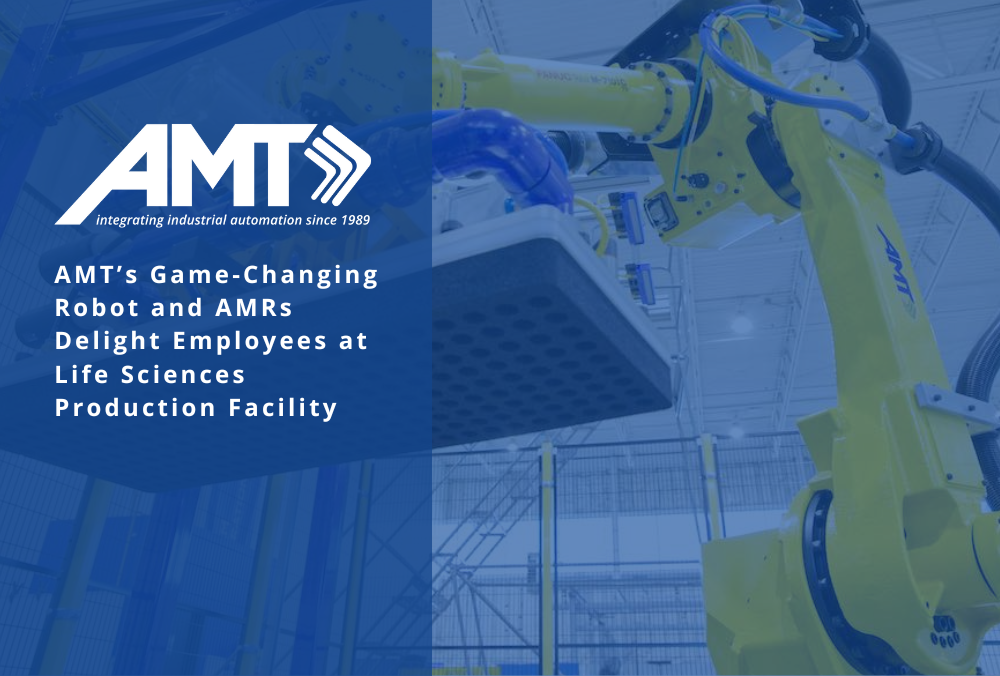AMT’s Industrial Robot and AMRs Delight Life Sciences Employees
Specializing in end-of-line solutions and autonomous mobile robots (AMRs), AMT engineers integrated a six-axis robot and two MiR AMRs in a life science production facility in Massachusetts. Workers from the facility have fondly nicknamed the robot, and the company produced a video sharing the warm welcome the new automation received from employees at the plant and the company’s plans for expansion of the project.
Are robots taking jobs? No! Rather, this is a prime example of how robots can improve the work environment for the happier and healthier employees working alongside them.
A leading supplier to the life sciences industry hired AMT to create a system to design, build, and install an end-of-line system to erect empty boxes and palletize full boxes for the company’s Massachusetts facility and two autonomous mobile robots (AMRs) to enhance productivity and workplace conditions. The completed project was such a success that it will be replicated and expanded in another of the company’s facilities.
The head of automation at the client’s site shared the positive effect the completed project has had on employees. “[My team] works tirelessly to improve efficiency and the work environment of our life science sites through the application of automation technologies. Recently, the team worked with [one of our sites] to install end-of-line automation technology, and we plan to bring similar technologies to other sites in the near future.”
“This project, I think, really was able to break down a lot of barriers and a lot of concerns that people have in terms of automation and robots and how potentially scary those things can be,” said an automation engineer at the client’s site. “It really showed people that automation is not scary. Automation is here to help and kind of be our friend.”
Box Erecting and Palletizing Process
“We were thrilled to deliver a robotic solution that had such a large and lasting impact on the employees’ well-being,” said AMT President Craig Salvalaggio.
Using a FANUC R2000iC/125L robot and PIAB vacuum end effector, the system picks a flat box from a knock down flat (KDF) box flat magazine-style cart in the cell and erects it with a box forming tool and then seals the bottom with an IPG case sealer. The robot is programmed to pick and erect boxes in a range of sizes, and control is through an Allen-Bradley PLC and HMI.
The box is then placed on a Hilmot conveyor system with cross transfer and weight scale, which takes it to an operator to be loaded. Once loaded, the box passes through three IPG taping stations and under a CTM labeler.
The robot picks a standard 40”x48” plastic pallet from a stack in the cell and places it onto the outgoing Phoenix pallet conveyor. The robot then picks a full box and applies a series of up to four labels to it before placing it on the pallet. The system is programmed to load the pallet with differing configurations of boxes depending on box size. Once the pallet is full, it passes through a stretch wrapping station and departs the cell to be unloaded by fork truck.
Autonomous Mobile Robots (AMRs)
AMT, who specializes in AMRs for warehousing and logistics applications, integrated two MiR units to move product on special carts from a clean room to an operator station or cart buffer.
A Warm Reception
Here’s what the client’s employees said about the project:
“[The robot] is amazing. We have a lot of good things in this company, but [the robot], it changed our lives,” said the team lead. “We are very grateful with the company and with [the robot] because we go home not over tired because [the robot] is helping us a lot.”
Another team lead said, “We are all happy to have [the robot]. We have less paperwork, we have less mistakes, and I think [we are] more productive.”
For more information on the project or AMT’s end-of-line robotic solutions, please reach out.

